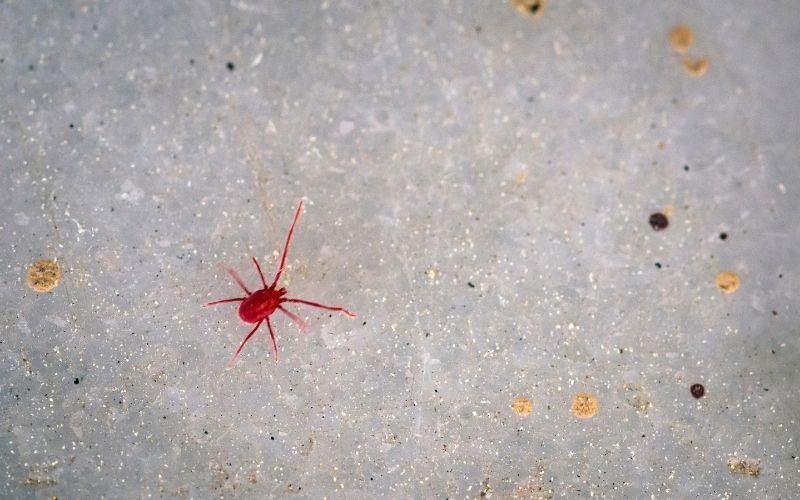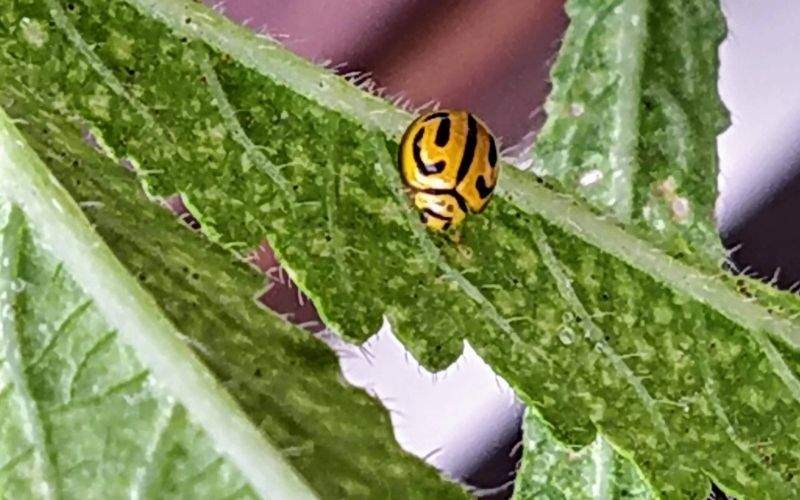Spider mites are yellowish or reddish colored plant pests that are microscopic and barely visible to the naked eye. They can feed on plant sap and cause damage to almost all types of vegetable plants and other types of plants.
The damage they cause is severe and results in the disfiguration and damage to the ability of leaves, flowers, and fruits to function properly, making the plant less productive. Spider mites will eventually kill the plant if nothing is done to control and stop them from spreading.
An adult spider mite can draw out the sap from about a hundred cells each minute and consume about half of its body weight in an hour. The damage done can also make the leaves drop prematurely.
Spider mites will damage all green leaves, including young leaves. Once they run out of leaves to feed, they may move onto vegetables. Their feeding behavior on vegetables causes a similar spotting and scarring pattern. They can also damage flowers, giving them a bruised look and stopping the plant from properly producing any more fruiting vegetables.
When spider mites puncture leaves, the plant activates defense mechanisms that are meant to stop spider mites from continuing to damage the plant. The spider mites then inject saliva that contains compounds that can stop the action of these defense mechanisms. The saliva they inject may also contain compounds that cause the plant to be easily affected by plant pathogens and viruses.

Will spider mites spread to other plants?
When a host plant is no longer able to supply enough nutrients for all the spider mites on it, some of the spider mites may crawl onto another host plant or allow themselves to be carried away by the wind. They can also use their webbing to form a silk-ball that can enclose several individuals, which is then carried away by the wind.
When spider mites move using silk-balls, they can travel anywhere from a few hundred meters up to 3 km. This means that it may be virtually impossible to know where the spider mites on your plants have come from if there are no infected plants nearby.
Can spider mites live without plants?
Spider mites actively feed on plants throughout the year in tropical, subtropical climates and in greenhouses. If the weather is warm enough it is very unlikely to find spider mites away from any plants since they will not actively leave a plant.
In temperate climates, spider mites stop feeding as temperatures decrease and go into a hibernating-like state. They hide in leaf litter and crevices in the barks of trees when in this state and wait until temperatures increase again to reappear.
When do spider mites appear?
Most types of spider mites are more likely to spread under warm and dry weather conditions. Spider mites grow and multiply much faster under moderately warm tropical or greenhouse temperatures and can suddenly increase in numbers at these temperatures. Warm and dry conditions can also negatively affect pathogenic fungi that naturally control spider mites.
This means that plants in moderately warm tropical climates or greenhouses, especially if they have not been given enough water, are more likely to attract spider mites. After one plant has been affected other plants near it can easily be affected because spider mites can walk over to them.

How to rid of spider mites naturally?
If you are a vegetable grower growing a limited number of plants at home, you can easily prevent your plants from being damaged by spider mites and get rid of them without using harsh chemicals.
- Check your plants regularly for signs of spider mites
The easiest and most important way to prevent spider mite infestations is by identifying the first signs of spider mites before they turn into a full-blown infestation.
You can remove spider mites and their eggs from plants by using a damp cloth to wipe leaves, especially the underside of the leaf. However, you must continue to wipe the leaves every 3 – 4 days to get rid of any eggs and adults that may have been missed.
It is particularly important to check your container-grown plants kept indoors or on balconies and terraces regularly for signs of spider mites, as these plants may be more likely to be affected by spider mites than plants grown on the ground.
- Keep affected plants away from other plants
If your plants are grown in containers, you should move any plants that have been affected by spider mites away from other plants to stop the spread. Although plants of the same variety are more likely to get spider mites from nearby plants, spider mites can feed on almost all types of plants, so it’s best to keep all unaffected plants away.
- Properly dispose of affected plant material
If you remove any leaves, vegetables, or flowers that have been damaged by spider mites, you must properly dispose of them, as they may still have adult spider mites or eggs that can spread to other plants. The affected plant parts that have been removed can be added into a container filled with boiling water to kill any spider mites.
- Keep your plants healthy
Prevention is always easier than control. If any of your vegetable plants have been affected by spider mites, it is very important that you optimize maintenance and care of all other plants in your garden. This will make it harder for spider mites to move to the other plants and will stop them from spreading.
Regularly watering your plants, especially during hot and dry periods, and fertilizing your plants as often as needed can help protect your plants from spider mites and all other types of pests.
Low levels of nitrogen fertilizer have been found to lead to spider mite infestations. Plants that are healthier are more capable of withstanding damage caused by spider mites and will also be able to have stronger defense mechanisms against spider mites.
- Encourage or release predators of spider mites
Spider mites can be biologically controlled by either releasing or encouraging the increase of predatory insects that feed on them.
The most important spider mite predator, spider mite destroyer, is a small, dark-colored ladybug beetle that will seek-out and feed on spider mites. Adult spider mite destroyers live for more than a year and can eat 75-100 spider mites a day.
Predatory mites are another important predator of spider mites. Other generalized predatory insects, including the western damsel bug, predatory thrips, minute pirate bugs, big-eyed bugs, lacewings, and even other types of lady beetles can help control the spread of spider mites.
An important point to remember when you use predators to biologically control spider mites is to refrain from using chemical pesticides, since these may also harm the predators.
Additionally, since there is a limit to the number of spider mites that a predator can eat each day, predators may not be effective after the number of spider mites has rapidly increased. This means that the predators may need your help to first bring down the number of spider mites to levels that they can manage.

Have you had to deal with spider mites damaging your vegetable plants? How did you get rid of them? – Let us know in the comments

